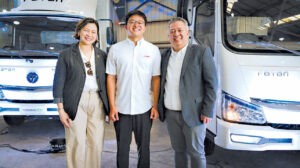By Kap Maceda Aguila
THE PATH to motoring electrification is getting increasingly well-paved — and wider — all the time, as more brands and their fully electric models are filling up various vehicle categories, from small passenger cars all the way up to large tractor heads. It’s starting to look like an embarrassment of EV (electric vehicle) riches, even if it seems we are still wanting in terms of charging infrastructure rollout and ubiquity.
That was the veritable crux of the message from Foton Motor Philippines recently, which hosted an event right at its assembly facility in the Clark Freeport Zone. Dubbed “EV Forward,” it was a chance for the Chinese brand with a considerable presence and history in the country (including its production line) to collect and flex all of its battery electric vehicle offerings.
Foton Motor Philippines Deputy Sales Director Joshua Sytin, in a speech, described the event as a “glimpse into the future of transport logistics — one that is cleaner, smarter, and more sustainable.” He stressed that the company’s “commitment doesn’t stop at delivering electric vehicles. We are dedicated to providing a complete ecosystem designed to support… operations with integrated, future-ready solutions.”
Among the models on display was the huge Foton EST 6×4 Tractor Head EV, a heavy-duty puller with a 282-kWh battery. It enlists 483hp and 2,100Nm to tow a maximum of 45,000kg. Foton reported that DC (direct current) charging to full capacity can take as short as one hour, 40 minutes (at 160kW), with range stretching to 200 kilometers. The Foton Tornado 3.6 EV, on the other hand, is a full-electric light-duty truck outputting 154hp and 300Nm from its 81.14-kWh battery. Driving range is 208 kilometers; payload capacity is 3,600kg. The Foton Transvan HR Cargo EV is able to accommodate up to 1,100kg of payload. Peak output is 114hp/290Nm, with a driving range of 195 kilometers.
The Foton Harabas TM300 EV, a full-electric light commercial vehicle, gets a 39.64-kWh battery which realizes 101hp and 220Nm from the electric motor. Driving range is 220 kilometers, while payload capacity is at 1,340kg. Using an 80-kW DC charger, its battery can be completely charged in 30 minutes. The Harabas is also configurable depending on the “dry” cargo. “Velocity” asked if a fully electric refrigerated van is available as a custom order. At the moment, the Harabas unit cannot support this yet (due to the cooling unit’s massive energy demand), but there are Foton “reefer van” models in China that are being studied for import into the country, according to officials.
Lastly, the Foton Traveller Sierra EV is a full-electric, 12-passenger van boasting up to 303 kilometers of range. Powered by a 77.28-kWh battery, its motor generates a maximum of 135hp and 330Nm, and can be charged to full in as little as 55 minutes via an 80-kW DC charger.
Foton Motor Philippines General Manager Levy Santos said to guests that the brand “stands at the forefront of sustainable transport solutions and a leading proponent of full electric vehicle solutions for both businesses and communities. Our vision is clear: to provide mobility that not only drives productivity but also protects the environment, reduces fuel costs, and minimizes maintenance expenses — empowering enterprises to achieve greater operational efficiency while contributing to a cleaner, greener future.”
The marque’s selection of battery electric vehicles are said to be able to empower enterprises while reducing their environmental impact, and “drive long-term business value.” Foton Motor Philippines is also set to bring in the full-electric Foton Bus, which can ferry 33 passengers (excluding the driver) as far as 350 kilometers per full charge. The 200.54-kWh battery — which can be charged to 100% in as fast as an hour and 15 minutes via 160-kW DC charging — delivers 248hp and 2,100Nm.
With a perceived range of benefits over their internal combustion engine counterparts, these full-electric models are expected to test not just the readiness of entrepreneurs and firms to the idea of full-electric workhorses, but should help further raise awareness of — and speed up the charging infrastructure development for — electric vehicles.

